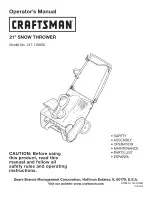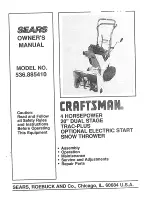
P2
P1
P4
P3
GB - 24/63
Also compare the values measured with those indicated in the
“CHARACTERISTIC DATA” table on page 3.
See chapter 9 “TROUBLESHOOTING” for preventing
possible breakage or faults.
Measuring vibrations
Measurements to determine vibration speed [mm/s] must be
carried out using an electronic vibration meter at the points
indicated below (see the figure below).
-
Points P1
and
P2 (front bearing):
The vibration meter
must be put on the cover near the bearing seating, and the
highest value must be recorded.
-
Points P3
and
P4 (back bearing):
The vibration meter
must be put on the electric motor casing near the bearing
seating (not on the fan guard), and the highest value must
be recorded.
The results must be evaluated by comparing the maximum
speed value measured with the limits laid down for the zones
(A, B) shown in the table below, in compliance with ISO 14694.
Effective
vibration speed
value [mm/s]
Class I
(
≤
15kW)
Effective
vibration speed
value [mm/s]
Class II
(> 15kW)
1.8
A
2.8
A
4.5
B
7.1
B
Legend:
Machine classification:
Class I
= SCL with electric motor power
≤
15 kW
Class II
= SCL with electric motor power > 15 kW
Evaluation zones:
Zone A
= SCL with vibrations within this zone are considered
acceptable for long-term service.
Zone B
= SCL with vibrations within this zone are considered
unsuitable for continuous long-term service. Under these
conditions the machine can be operated for a limited period,
until the opportunity arises for suitable corrective work to be
done.
When the unit is stopped, routinely carry out the following
checks:
-
Dust deposits: Check and , if necessary, use suitable
equipment to remove deposits on the external surfaces of
the unit that may impede correct heat exchanging.
-
Suction filter: Every 8-10 days check and if necessary
clean or replace the filter cartridge. In very dusty
environments, change the filter more frequently. A dirty
cartridge creates extensive resistance at the suction,
resulting in an increase in: the pressure differential, the
power absorbed, and the operating temperature. The load
loss must not exceed 30 mbar.
6 MAINTENANCE
Danger resulting from the impeller seizing
due to excessive vibrations!
Vibration values exceeding zone B (table of effective
vibration speed values) are considered NOT admissible and
may cause damage to the machine and resulting serious
injury and even death!
- If any anomalous noises and/or vibrations are detected,
these may be a warning that the impeller is about to
seize, switch off the unit and move away from it
immediately.
Electrical danger!
- Before doing anything else, make sure that the power
supply is NOT switched on.
Danger due to burns caused by contact with
hot surfaces on the unit!
When operating the compressors-vacuum pumps can reach
high surface temperatures of up to 160°C (+320°F).
- Before starting with any work, wait for the unit to cool
down after switching it off!
Any use other than the intended use of the
unit may cause serious injury and even
death!
Maintenance may only be carried out on the unit:
If the maintenance instructions, parts list, and
section/exploded view of the relevant unit are available.
After having carefully read, fully understood, and complied
with this operating manual (“SAFETY STANDARDS”
“STORAGE AND TRANSPORT” and “INSTALLATION”).
In conformity with the purposes laid down under
“INTENDED USE”.
By qualified personnel, that is, personnel whose training,
instruction, experience, knowledge of standards, regulations,
accident prevention procedures, and operating and service
conditions, makes them capable of carrying out all the works
necessary, while being aware of and avoiding any possible
danger and/or damage.
Danger due to burns caused by contact with
hot surfaces on the unit!
When operating the compressors-vacuum pumps can reach
high surface temperatures of up to 160°C (+320°F).
- Before starting with any work, wait for the unit to cool
down after switching it off!
Electrical danger!
- Before doing anything else, make sure that the power
supply is NOT switched on.
















































